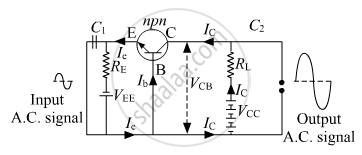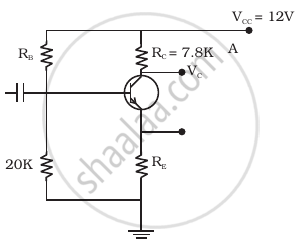Advertisements
Advertisements
प्रश्न
Derive the expression for the voltage gain of a transistor amplifier in CE configuration in terms of the load resistance RL, current gain βa and input resistance.
Explain why input and output voltages are in the opposite phase.
उत्तर

Let Ri be the input resistance of the emitter-base circuit. When an input signal voltage Vi is applied to the emitter-base circuit, let ΔIb, ΔIc be the change in base current and collector current respectively.
Then, Vi = ΔIb × Ri
Then ac current gain of the transistor is,
Current gain, `beta_"a" = (Delta "I"_"C")/(Delta "I"_"B")`
⇒ Δ IC = βa × ΔIB
Also, VCE = VCC -ICRL
As the change in the base current changes the collector current but not VCC, so,
ΔVCE = 0 - ΔICR = - (βa Δ IB) RL
Output voltage, V0 = ΔVCE - βa Δ IBRL
The voltage gain of the common emitter amplifier,
`"AV" = "V"_0/"V"_"i" = (-beta Delta "I"_"B""R"_"L")/(Delta "I"_"B""R"_"i") = -beta_"a" "R"_"L"/("R"_"i")`
`"AV" -beta_"a" "R"_"L"/("R"_"i")`
Here, -ve sign shows that the output voltage is 180o out of phase with the input voltage. i.e. input voltage and output voltage are in the opposite phase. As the input voltage rises, so the current increases through the base circuit, this increases the current through the collector circuit. This results in the voltage between the collector and emitter terminals falling.
APPEARS IN
संबंधित प्रश्न
Draw a simple circuit of a CE transistor amplifier. Explain its working ?
Show that the voltage gain, AV, of the amplifier is given by `A_v = (beta_(ac) R_1)/r_i`where βac is the current gain, RL is the load resistance and ri is the input resistance of the transistor. What is the significance of the negative sign in the expression for the voltage gain?
Let iE, iC and iB represent the emitter current, the collector current and the base current respectively in a transistor. Then
(a) iC is slightly smaller than iE
(b) iC is slightly greater than iE
(c) iB is much smaller than iE
(d) iB is much greater than iE.
In a normal operation of a transistor,
(a) the base−emitter junction is forward-baised
(b) the base−collector junction is forward-baised
(c) the base−emitter junction is reverse-baised
(d) the base−collector junction is reverse-baised.
Draw a circuit diagram of an n-p-n transistor with its emitter-base junction forward biased and basecollector junction reverse biased. Briefly describe its working.
Explain how a transistor in its active state exhibits a low resistance at its emitter-base junction and high resistance at its base-collector junction.
Derive the expression for the voltage gain of a transistor amplifier in CE configuration in terms of the load resistance RL, current gain a βa and input resistance.
Explain why input and output voltages are in opposite phase.
Draw a circuit diagram of an n-p-n transistor with its emitter-base junction forward biased and base-collector junction reverse biased. Briefly describe its working.
Explain how a transistor in its active state exhibits a low resistance at its emitter-base junction and high resistance at its base-collector junction.
Answer the following question.
Draw the circuit arrangement for studying the output characteristics of an n-p-n transistor in CE configuration. Explain how the output characteristics is obtained.
For the transistor circuit shown in figure, evaluate VE, RB, RE given IC = 1 mA, VCE = 3 V, VBE = 0.5 V and VCC = 12 V, β = 100.

